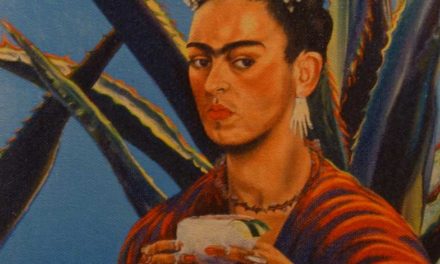Jesse Trevino has been painting for nearly 50 years. Now with the new publication of Spirit: The Life and Times of Jesse Treviño by Anthony Head, his full biography is finally available. Head’s book, with a foreword by Henry Cisneros, will engage you. The book will also make you wonder why it took long for someone to capture such a beautiful and inspiring story.
Jesse Trevino, one of America’s premier Latino artists, grew up in the Westside San Antonio neighborhood called Prospect Hill. His family of eleven brothers and sisters lived in a modest home on Monterey Street. His life-long friend, Henry Cisneros, grew up a block away on the same street.
I knew the neighborhood well having lived on Monterey Street a few blocks from Trevino and Cisneros. Two other notable artists also lived nearby: Rolando Briseno on Monterey Street and Lionel Sosa two blocks north on Commerce Street. Trevino and I went to the same elementary school and attended Fox Tech High School only a few years apart.
When the Smithsonian began collecting Latino art in the late 1990s, Jesse Trevino ranked at the top of their list to add to that world famous museum. Thanks to a gift from his old Prospect Hill neighbor, Lionel Sosa, the Smithsonian acquired Trevino’s “Mis Hermanos” (My Brothers) which Trevino painted in 1976.
Talking about his new book, Head told Matt Joyce of Texas Highways magazine that “ At its heart, this is a story of sheer determination to follow a dream. When he was at his lowest, Jesse found faith in himself to continue working. He simply was not going to be denied the life he always wanted to live.”
Trevino’s early years were formative and important to his development as an artist. Finishing high school in 1965, Jesse headed East to the prestigious Art Students League of New York on a scholarship. His mentors and teachers were some of America’s finest portrait painters and he studied alongside some of the brightest young artists in the nation.
In the 1960s New York was considered among the top three places in the world to pursue the study and practice of art. Texans that arrived in the Big Apple during that vibrant era included the young Luis Jimenez who taught teens art by day in the Bronx and painted by night. Jimenez and Trevino were among the first Latinos whose work the Smithsonian sought to acquire.
Trevino did not have the opportunity to stay long in New York as the United States Armed Services commenced an expansion of their involvement in the Vietnam War. In Texas Highways, Head described Trevino’s Vietnam service and his return from the war as the beginning of a tortured experience extending from many months to many years. Head wrote: “Under heavy fire, he sustained life-threatening injuries including to his right arm, which he painted with. Eventually, that arm was amputated below the elbow, but not after Jesse had already started training himself to live left-handed—especially as an artist.”
In the early 1990s Trevino’s good friends Jorge Cortez, owner of the well known Mi Tierra Mexican Restaurant in San Antonio, and fellow Fox Tech High School graduate, Dr. Carlos Orozco, suggested that Jesse paint a large mural at Market Square or at Christus Santa Rosa Hospital just a block from the Cortez family restaurant. Trevino always loved monumental art and proposed painting a mural on the entire nine-story hospital wall facing south which could be viewed from the elevated I-35 Highway.
Trevino’s Spirit of Healing mural is a gigantic 93 feet by 43 feet which required thousands of small pieces of tile of 70 different colors. At its completion, the art piece was reputed to be the largest ceramic mural in America. The mural depicts a young boy (his son) holding a dove under the watchful protection of a guardian angel.
We have had friends tell us that they wanted to see three things in San Antonio: the Alamo, the Riverwalk, and the Trevino Spirit of Healing mural. Because of its central location near touristy Market Square and the busy I-35 corridor, this mural is viewed by millions every year.
I posted a few questions about the book to author Anthony Head:
How did you get interested in Jesse Trevino as a subject for your book?
“In mid-2011, after seeing Jesse’s ‘Mi Vida’ exhibition at the former Museo Alameda, I was interviewing him for Texas Highways when I realized that his story was so much more than just that of injury and recovery. It was about family, civil rights, the Chicano experience, Prospect Hill, and an unflagging belief in oneself.”
How many years did the book project take and what surprised you the most as you wrote it?
“From the time Jesse said yes until final publication, it took seven years, which was much longer than I first anticipated…I was surprised at how many pieces—original works, not prints—there are in the cafes, homes, churches, and businesses throughout San Antonio and beyond. I’m still discovering paintings that are new to me.”
Who did you intend the audience to be for SPIRIT?
“I intended to introduce Jesse and his story to a wider audience, in San Antonio specifically, but everywhere really. I’ve found there are a lot of San Antonians who have heard of Jesse Treviño, know Jesse Treviño, or have seen some of his art around the city whether or not they know who created it. This book pulls together the events of his life for the first time. And for those people not in one of those categories, Jesse’s life should appeal as the archetypal San Antonio story.”
SPIRIT is a great book–one that deserves a wide readership. I found my copy at the Twigg Book Store at the Pearl.










